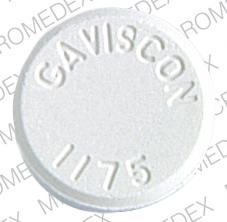Aluminum hydroxide/magnesium trisilicate and Alcohol/Food Interactions
There is 1 alcohol/food/lifestyle interaction with aluminum hydroxide / magnesium trisilicate.
Aluminum Hydroxide Food/Lifestyle
Major Food Interaction
Consumer information for this interaction is not currently available.
GENERALLY AVOID: The concomitant administration of aluminum-containing products (e.g., antacids and phosphate binders) and citrates may significantly increase serum aluminum concentrations, resulting in toxicity. Citrates or citric acid are contained in numerous soft drinks, citrus fruits, juices, and effervescent and dispersible drug formulations. Citrates enhance the gastrointestinal absorption of aluminum by an unknown mechanism, which may involve the formation of a soluble aluminum-citrate complex. Various studies have reported that citrate increases aluminum absorption by 4.6- to 50-fold in healthy subjects. Patients with renal insufficiency are particularly at risk of developing hyperaluminemia and encephalopathy. Fatalities have been reported. Patients with renal failure or on hemodialysis may also be at risk from soft drinks and effervescent and dispersible drug formulations that contain citrates or citric acid. It is unknown what effect citrus fruits or juices would have on aluminum absorption in healthy patients.
MANAGEMENT: The concomitant use of aluminum- and citrate-containing products and foods should be avoided by renally impaired patients. Hemodialysis patients should especially be cautioned about effervescent and dispersible over-the-counter remedies and soft drinks. Some experts also recommend that healthy patients should separate doses of aluminum-containing antacids and citrates by 2 to 3 hours.
ADJUST DOSING INTERVAL: The administration of aluminum-containing antacids with enteral nutrition may result in precipitation, formation of bezoars, and obstruction of feeding tubes. The proposed mechanism is the formation of an insoluble complex between the aluminum and the protein in the enteral feeding. Several cases of esophageal plugs and nasogastric tube obstructions have been reported in patients receiving high-protein liquids and an aluminum hydroxide-magnesium hydroxide antacid or an aluminum hydroxide antacid.
MANAGEMENT: Some experts recommend that antacids should not be mixed with or given after high protein formulations, that the antacid dose should be separated from the feeding by as much as possible, and that the tube should be thoroughly flushed before administration.
Switch to professional interaction data
Aluminum hydroxide/magnesium trisilicate drug interactions
There are 261 drug interactions with aluminum hydroxide / magnesium trisilicate.
Aluminum hydroxide/magnesium trisilicate disease interactions
There are 2 disease interactions with aluminum hydroxide / magnesium trisilicate which include:
More about aluminum hydroxide / magnesium trisilicate
- aluminum hydroxide/magnesium trisilicate consumer information
- Check interactions
- Compare alternatives
- Reviews (11)
- Side effects
- Drug class: antacids
- En español
Related treatment guides
Drug Interaction Classification
| Highly clinically significant. Avoid combinations; the risk of the interaction outweighs the benefit. | |
| Moderately clinically significant. Usually avoid combinations; use it only under special circumstances. | |
| Minimally clinically significant. Minimize risk; assess risk and consider an alternative drug, take steps to circumvent the interaction risk and/or institute a monitoring plan. | |
| No interaction information available. |
See also:
Further information
Always consult your healthcare provider to ensure the information displayed on this page applies to your personal circumstances.


